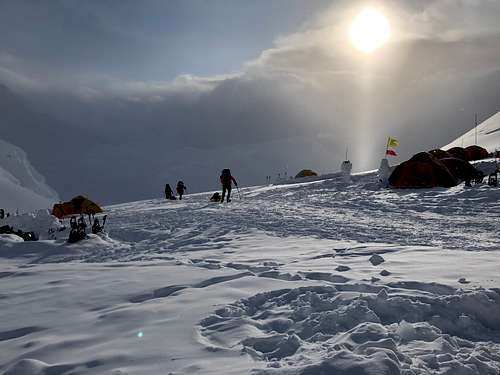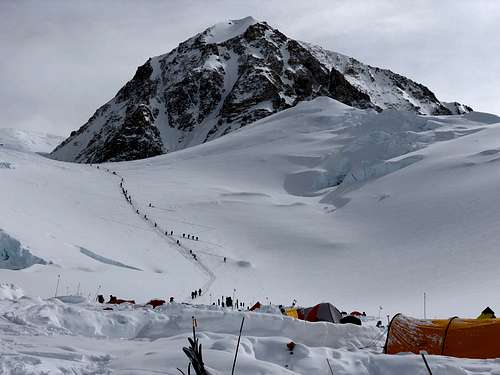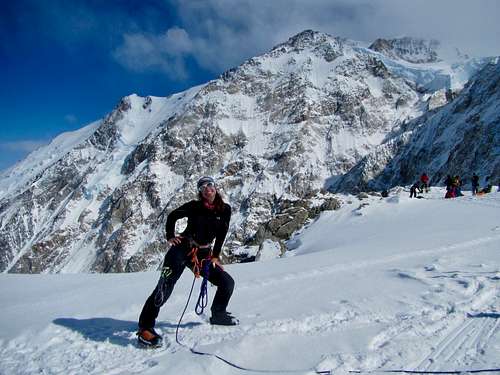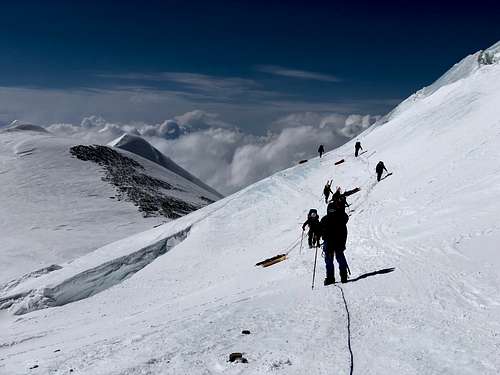Introduction
I was preparing a trip to Denali for many years now. It was just hard to co-ordinate time, work schedules, family obligations etc. Initially, I was considering going solo, but I was concerned about crevasses, so when my friend offered to come along I was excited. We do a lot of activities together, mostly rock and ice climbing, mountain biking and some peaks in Colorado. He is faster and I last longer. We did some training together, and some on our own with me preferring to summit as many peaks as I could, and sleep high. Sleeping high meant either snow camping around and above 12,000 feet, or sleeping at numerous Colorado high mountain passes in my car. We are lucky to live in Colorado with so many options. I spent a couple of weekends never dropping below 11,500 feet (3,500 meters) hiking, skiing, summiting peaks and camping. My friend preferred biking and bouldering and did not like being told what to do. We planned that he may not go for the summit and remain at 14,000 camp if he would not feel good. He had a history of pulmonary edema when he was young (in his 20s, he is currently early 50s), and during our recent trip to Pico de Orizaba in Mexico, he did not feel good and experienced symptoms of AMS (acute mountain sickness) with severe headache, nausea and fatigue.
What is HAPE?
![Sunset]() Sunset
SunsetHigh Altitude Pulmonary Edema is a fluid accumulation in the lungs which happens in otherwise healthy individuals after an ascent to an altitude above 8,200 feet (2,500 meters). It is life threatening. The pathophysiology of the process involves breakdown in the pulmonary blood-gas barrier, which leads to leakage of plasma and even red blood cells in the lung. The breakdown develops from a number of maladaptive responses to the hypoxia (= low oxygen levels) encountered at higher altitudes, including poor ventilatory response, increased sympathetic tone, exaggerated and uneven pulmonary vasoconstriction (= high blood pressure in the pulmonary system), inadequate production of endothelial nitric oxide (NO relaxes the pulmonary vessels and lowers pulmonary pressure) etc. Many of these factors are genetically determined.
HAPE rapidly reverses this process with descent to lower elevation, or simply with administration of oxygen. This differentiate HAPE from a respiratory infection, which would persist at lower elevation.
Symptoms of acute mountain sickness (AMS) develop in a high percentage of those with HAPE (up to 50%). HAPE and high altitude cerebral edema (HACE) can also occur concomitantly.
Factors associated with an increased incidence of HAPE include male gender, cold temperatures, preexisting respiratory infection and vigorous exertion. Pre-existing conditions that lead to increase pulmonary blood flow may predispose to HAPE (often you are not aware of these conditions prior your trip).
Presentation: HAPE generally begins with subtle, non-productive cough, shortness of breath with exertion and difficulty walking uphill. Such non-specific symptoms are often attributed to normal breathlessness at altitude. Initial symptoms typically appear two to four days after arrival at a new altitude.
As HAPE progresses, difficult breathing becomes noticeable at rest and severe with any attempt at exertion. Even walking on a level surface becomes an effort.
As symptoms progress, the cough can become productive of pink, frothy sputum and may produce frank blood. Severely restricted exercise tolerance becomes debilitating and severe hypoxemia (= low blood oxygen levels) may become life threatening without prompt descent. Severe hypoxemia (= low blood oxygen levels) can cause drowsiness or concomitant high altitude cerebral edema.
On exam, fast heart beat, fast breathing are common. Inspiratory crackles may be more prominent in the right middle lobe initially, but become more diffuse. If you have a stethoscope listen to mid chest area.
Pulse oximetry reveals saturation values at least 10 points lower than expected for the altitude, and absolute values can be as low as 50 to 60%. Typically, the patient appears better than expected given the severity of hypoxemia (= low oxygen levels in the blood), and the oxygen saturation improves promptly (usually within 10 - 15 min) if given oxygen.
Normally, oxygen saturation is lowest the first day at high altitude and rises over four days to a near maximum value, usually 3 to 5 points higher that day one. Although expected values can vary widely in normal individuals at any given altitude, comparing oxygen saturations with others in the same group can help to establish “normal” values.
![Motorcycle Hill]() Motorcycle Hill
Motorcycle HillTreatment: Descent is often effective alone and superior to any pharmacological therapy. (Patient with severe HAPE should not carry a pack while descending). Oxygen is great, but that is hard to get on Denali. Rest and warmth - limit exercise and drink plenty of fluids.
Hyperbaric therapy - light weight portable hyperbaric chambers can be life saving. They are expensive though and most climbers do not carry this equipment.
Pharmacologic management: descent is preferable and superior to medications!
Nifedipine decreases pulmonary artery pressure, and is the drug of choice for treatment. The dosing is 30 mg of extended release formulation every 12 hrs. Cialis and Viagra are also effective in prophylaxis of HAPE, and may help a little when HAPE develops too. Both work by lowering pulmonary artery pressure.
Dexamethasone (steroid) is better for treatment of HACE and AMS, it may have a use in prophylaxis of HAPE.
Salmeterol is an inhaler used for treatment of asthma (longer acting then more commonly used albuterol) - it may provide some relief too.
Regarding Diamox (=acetazolamide): per Up To Date (most recent and updated medical research) is preferred agent for prevention of AMS and HACE, but not HAPE. It can be used as an alternative for prevention of HAPE though. The dose is 125 mg every 12 hrs, start day before the ascent and continue 2-3 days at maximum altitude. Many people feel dry mouth, changes in taste and tingling in their fingers as a side effect.
Our Case
![Father and Sons Wall]() Father and Sons Wall
Father and Sons WallMy friend woke up in the middle of the night at camp 11,000 and told me that he has gargling sounds in his lungs. This was our 2nd night at 11,000 and earlier that morning we carried a cashe to 13,500 feet. He started the day strong and fast, but at the cashe site he was tired and I did most of the digging. He tripped on the way down around Windy Corner area. This is the classic presentation - 2nd night at higher camp, and day after a lot of exertion. The gargling happened only in one position. He had no cough, or maybe 2 tiny coughs throughout the whole night. He had no headache or nausea (AMS). Good - no imminent danger. He has been taking diamox, but only half dose 62.5 mg because of above mentioned side effects. It was cold and snowing outside. My medical kit did not carry nifedipine, so I gave him 4 mg of dexamethasone, drink of tea and another dose of Acetazolamide 125 mg. I was not prepared for him getting sick at 11 K. My brain was racing - what to do, do we need to go down now, or ok to wait till morning. He did not look that ill. He was not coughing or barely mildly. He was talking in full sentences without shortness of breath. We decided to wait till the morning (only 3-4 hrs longer). He felt better. Oxygen saturation was 86% (normal for the altitude), when asked to run up a few meters in the camp, the oxygen saturation dropped only to 84% (again normal for the altitude), but his heart rate was high 140. He still felt the gargling sounds, but less. I did not carry a stethoscope to listen, but the gargle sound was audible to naked ear. Decision: my rule always has been once you take dexamethasone, you go down. It is only for an emergency. Our patient already had a severe case of pulmonary edema in the past (required hospitalization) and just a few months ago was really ill on Pico de Orizaba. Our patient was scared and worried about progression to worse. Flooding lungs is a scary feeling. Even if we decided to wait for a few days at 11,000, I would not feel comfortable going higher later on due to his history of past pulmonary edema.
I consulted with German Emergency Doctor camping next to us, who volunteered to watch over him and agreed we are safe to stay one more night while I went back to retrieve our cashe at 13,500. We did spent another night at 11,000 feet and our patient was feeling stronger and gargling sounds were almost gone, but he developed a mild and more persistent cough. The following morning we descended. He was strong and fast on descent. By the time we arrived to the air strip, he has no signs of pulmonary edema or respiratory distress.
Why they say Denali feels higher than other mountains?
![Windy Corner]() Windy Corner
Windy CornerHave you heard this statement before? I did. Mount Everest is located 28 degrees north and Denali 63 degrees north. It is likely that no climber would be able to reach the summit of Everest without oxygen if it would be located as far north as Denali. Physiologically, it would feel as if there were additional 3,000 feet added to the height of Mount Everest. Why? Because of the many factors which affect atmospheric pressure.
Atmospheric pressure (also known as barometric pressure) is very simply the weight of the air, the weight of the atmosphere pressing down on earth. At higher altitude, the atmospheric pressure is lower. This is because high places do not have much air above them.
Evangelista Torricelli, one of the first to discover atmospheric pressure once said, “We live submerged at the bottom of an ocean made of the element air”. Just imagine we are walking under the blanket of air and higher we go, the blanket gets thinner. But the blanket is not equally strong all over the globe. Air pressure is the highest at equator, and much lower at the poles. And the air pressure will decrease faster with height closer to poles (colder air) and decrease slower near the equator (warmer air).
So, at the poles, the atmosphere is much thinner than at the equator. Because of these variations, two mountain climbers at the same altitude but on different mountains could experience different atmospheric pressures and therefore different physiological effects. One climber might have no trouble breathing - he is climbing near the equator, while the other can barely pull enough oxygen to survive - he is climbing near the pole. The small amount of oxygen on the top of Everest puts this peak near a human’s physiological limit. And this is why, if it were at a higher latitude, it could be beyond the physiological limits of someone trying to climb it without oxygen.
Both high latitude peaks (Denali and Mount Vinson) have less oxygen that peaks of the same elevation new the equator.
Mental Preparedness
I think it is a good idea to prepare yourself ahead of what to do when one gets sick. Have a plan and be prepared to turn around for your friend/partner/unknown climber. Life is precious. I think we all want to believe that we would be able to turn around without any difficulty, but when the moment comes, it is hard. We have all read and heard stories of people going up Himalayan peaks and stepping over a nearly dying person instead of helping the suffering one to go down. Our goals and our motivations for reaching the summits are often not understood by the rest of the world and are not worth to waste a human life.
How do we know that high altitude illness is starting, or whether we are dealing with a normal acclimatization process. Observe. If not feeling good - rest, drink, and rest. Go up slowly - as they they on Kilimanjaro “Pole, pole” (slowly in Swahili). Do not stress yourself with other parties passing you. If are a sprinter, save your sprint for your return (yes, you can run up Heartbreak Hill on the way back if you wish to). And if you are getting worse, descent to a lower camp and wait until the energy and strength come back. You may feel better after 1-2 nights at lower elevation and be able to go back up again.
What is our goal? Hopefully, return home safely and with all body parts (thinking of severe frostbite injuries).
Montani Semper Liberi
External Links









Comments
Post a Comment